中国组织工程研究 ›› 2025, Vol. 29 ›› Issue (28): 6146-6160.doi: 10.12307/2025.469
• 生物材料循证医学 evidence-based medicine of biomaterials • 上一篇
可穿戴设备干预促进老年人身体活动的Meta分析
王锦福,杨 管
- 华南理工大学体育学院,广东省广州市 510641
-
收稿日期:2024-05-08接受日期:2024-07-08出版日期:2025-10-08发布日期:2024-12-09 -
通讯作者:杨管,博士,副教授,硕士生导师,华南理工大学体育学院,广东省广州市 510641 -
作者简介:王锦福,男,2000年生,广东省佛山市人,汉族,华南理工大学在读硕士,主要从事运动与健康促进相关研究。 -
基金资助:广东省哲学社会科学学科共建项目(GD22XTY01),项目负责人:杨管;广州市哲学社会科学发展规划共建课题(2023GZGJ327),项目负责人:杨管;广州市科技局一般项目(2023A04J1822),项目负责人:杨管
Meta-analysis of wearable device interventions to promote physical activity in older adults
Wang Jinfu, Yang Guan
- School of Physical Education, South China University of Technology, Guangzhou 510641, Guangdong Province, China
-
Received:2024-05-08Accepted:2024-07-08Online:2025-10-08Published:2024-12-09 -
Contact:Yang Guan, PhD, Associate professor, Master’s supervisor, School of Physical Education, South China University of Technology, Guangzhou 510641, Guangdong Province, China -
About author:Wang Jinfu, Master candidate, School of Physical Education, South China University of Technology, Guangzhou 510641, Guangdong Province, China -
Supported by:Guangdong Provincial Philosophy and Social Science Joint Construction Project, No. GD22XTY01 (to YG); Guangzhou City Philosophy and Social Science Joint Construction Topic, No. 2023GZGJ327 (to YG); General Project of Guangzhou City Science and Technology Bureau, No. 2023A04J1822 (to YG)
摘要:

文题释义:
可穿戴设备:应用穿戴式技术对人们日常的穿戴进行智能化配置,可以用来客观测量用户日常身体活动,通过监视显示器或合作应用程序提供反馈的便携式设备。身体活动:以骨骼肌牵引为特征的各种活动。身体活动结果是身体能量的利用和运动功能的参与。
目的:虽然可穿戴设备在促进老年人身体活动方面的潜在效益已得到认可,但现有研究针对该人群的具体效果尚未进行全面系统的评估。文章旨在系统评价可穿戴设备干预对老年人中高强度身体活动、低强度身体活动、总身体活动、每日步数以及久坐行为等身体活动相关指标的影响。
方法:通过PubMed、EMbase、Scopus、Ovid-Medline、The Cochrane Library、SPORTDiscus、CNKI、维普和万方等数据库检索文献,搜集关于可穿戴设备干预对老年人身体活动影响的随机对照试验,检索时限为各数据库建库至2024-03-10。采用Cochrane偏倚风险评估工具对纳入文献进行方法学质量评价,运用Review Manager 5.2和Stata 12.0软件进行数据合并、亚组分析、森林图绘制、敏感性分析、发表偏倚评价及单因素Meta回归分析。结果:①最终纳入43篇文献,包含5 194个样本量;②Meta分析结果显示,可穿戴设备干预对老年人每日步数(SMD=0.48,95%CI:0.33-0.62,P < 0.000 01)、中高强度身体活动(SMD=0.29,95%CI:0.20-0.38,P < 0.000 01)、低强度身体活动(SMD=0.17,95%CI:0.02-0.32,P=0.03)和总身体活动(SMD=0.15,95%CI:0.02-0.28,P=0.02)均有显著的促进效果,然而对改善老年人久坐行为无明显效果(SMD=-0.08,95%CI:-0.21-0.05,P=0.22);③亚组分析结果显示,采用综合干预措施、干预时间≤12周以及使用计步器作为干预设备对促进老年人低强度身体活动和总身体活动的效果更佳;采用综合干预措施、干预时间≤12周及使用加速度计为干预设备可能对促进老年人每日步数和中高强度身体活动更有效;④Meta回归结果表明,年龄(P=0.038)和健康状况(P=0.083)是影响每日步数异质性的重要因素。
结论:当前证据表明,可穿戴设备干预在促进老年人每日步数、中高强度身体活动、低强度身体活动和总身体活动方面具有积极作用,建议在设计可穿戴设备干预方案时,考虑采用综合干预方式、干预时间≤12周并根据干预目标选择合适的设备。尽管如此,对于减少久坐行为的干预效果尚需更多高质量随机对照试验来进一步验证。
https://orcid.org/0000-0001-6529-5530(王锦福);https://orcid.org/0000-0002-9559-247X(杨管)
中国组织工程研究杂志出版内容重点:生物材料;骨生物材料;口腔生物材料;纳米材料;缓释材料;材料相容性;组织工程
中图分类号:
引用本文
王锦福, 杨 管. 可穿戴设备干预促进老年人身体活动的Meta分析[J]. 中国组织工程研究, 2025, 29(28): 6146-6160.
Wang Jinfu, Yang Guan. Meta-analysis of wearable device interventions to promote physical activity in older adults[J]. Chinese Journal of Tissue Engineering Research, 2025, 29(28): 6146-6160.
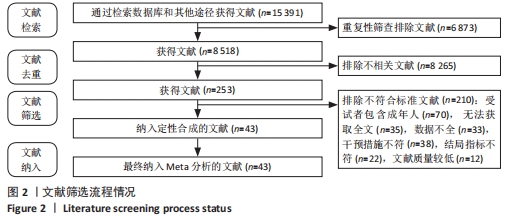
2.2 纳入研究的基本特征 所纳入的43项研究发表于2004-2022年间,来自澳大利亚、荷兰、美国、中国、比利时等国家,共涉及5 194例参与者,其中试验组2 701例,对照组2 493例。纳入研究的基本特征见表2。
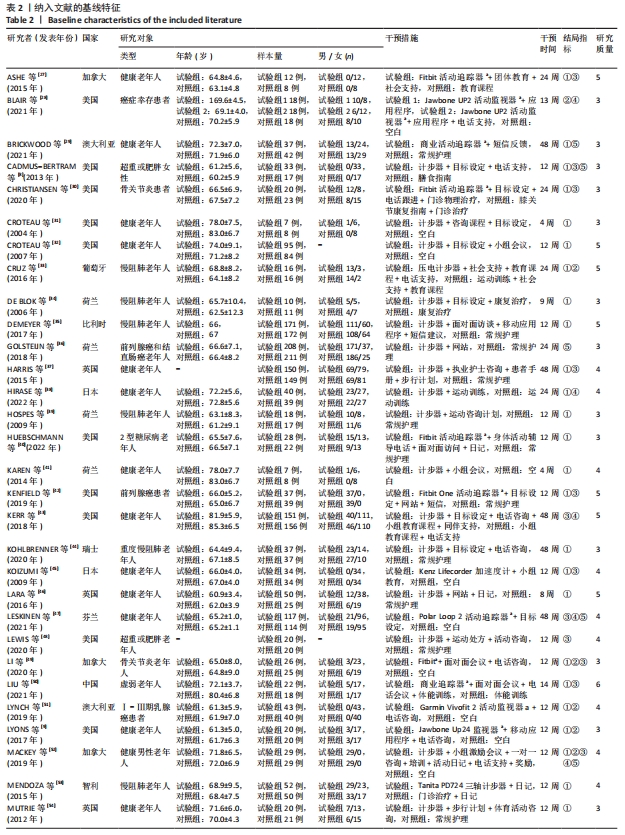

2.3 文献质量评价结果 纳入的43项研究均对参与者的基线情况进行报道,均提及“随机分配”,其中39项研究报告具体的随机方法(包括计算机生成的随机数字、信封)[8-10,27-33,35-38,40-62,64-65],23项研究描述具体的分配隐藏方案[8-9,11,27,29-30,32-33,35,37,42-43,45-47,49-51,54,57,61-62,64],11项研究对受试者实施盲法[27,33-34,38-39,42-43,46,50-51,59],9项研究对试验人员和结果评估人员实施盲法[10-11,35,37,43,50,52-53,57],28项研究数据报告完整[27-28,31-35,38-42,44,46-48,50,52-53,55-56,58-60,62-65],均对缺失结果数据或缺失原因进行描述,42项研究均无失实报道[8-11,27-65]。
根据Cochrane偏倚风险评估工具的文献质量评分,9项研究为高质量文献[27,32-33,35,42-43,46,50,62],34项研究为中等质量文献[8-11,28-31,34,36-41,44-45,47-49,51-61,63-65],见图3,4。Cohen’s kappa检验表明,2位评价者在文献质量评价结果上具有较好一致性,Cohen’s kappa系数为0.84。
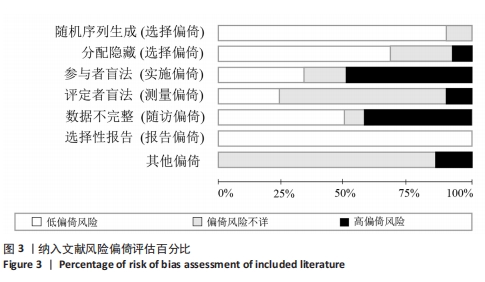
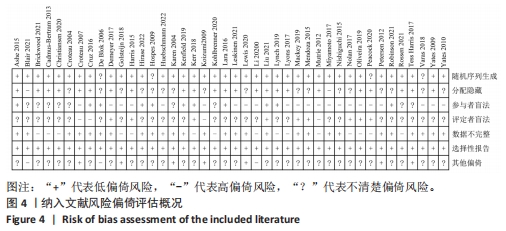
表3显示了可穿戴设备干预对老年人每日步数、中高强度身体活动、低强度身体活动、总身体活动和久坐行为的GRADE证据质量评价结果。所有指标由于存在不良偏倚风险,如未采用盲法或盲法的实施不充分,因此证据被降一级。每日步数由于异质性较大,因此证据再降一级。久坐行为由于存在严重的不精确性,如置信区间过宽,因此证据再降一级。最终,每日步数、中高强度身体活动、低强度身体活动、总身体活动和久坐行为的证据质量分别为低、中等、中等、中等和低。Cohen’s kappa检验表明,2位评价者在证据质量评价上一致性较好,Cohen’s kappa系数为0.85。
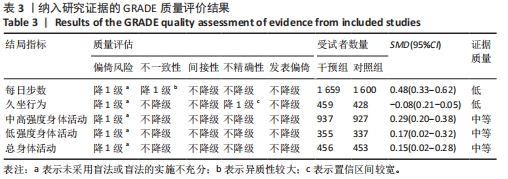
2.4 Meta分析结果
2.4.1 两组中高强度身体活动差异的Meta分析结果 从图5可知,15项研究报告了可穿戴设备对老年人中高强度身体活动的影响[8,27,30,33,37,42-44,47-52,62],各研究间统计学异质性较小(I2=20%,P=0.23),故采用固定效应模型进行分析。结果显示,两组间中高强度身体活动水平相比差异有显著性意义(SMD=0.29,95%CI:0.20-0.38,P < 0.000 01),提示可穿戴设备干预能够促进老年人的中高强度身体活动水平。
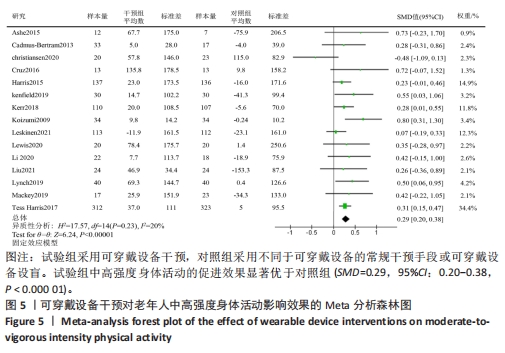
2.4.2 两组每日步数差异的Meta分析结果 从图6中可见,35项研究报告了可穿戴设备对老年人每日步数的影响[8-9,27,29-35,37-42,44-46,49-57,59-65],各研究间统计学异质性较大(I2=72%,P < 0.000 01),故采用随机效应模型进行分析。结果显示,两组间每日步数相比差异有显著性意义(SMD=0.48,95%CI:0.33-0.62,P < 0.000 01),提示可穿戴设备干预能够有效提高老年人的每日步数。
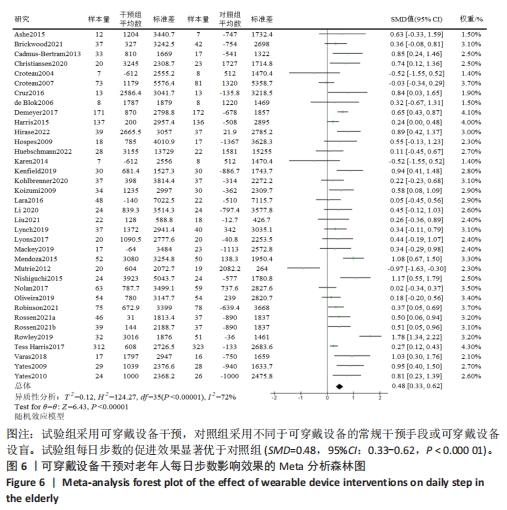
2.4.3 两组低强度身体活动差异的Meta分析结果 在图7中,6项研究报告了可穿戴设备对老年人低强度身体活动的影响[28,38,43,47,51-52],各研究间异质性较小(I2=21%,P=0.27),故采用固定效应模型进行分析。结果显示,两组间低强度身体活动水平相比差异有显著性意义(SMD=0.17,95%CI:0.02-0.32,P=0.03),提示可穿戴设备干预能够有效促进老年人的低强度身体活动水平。
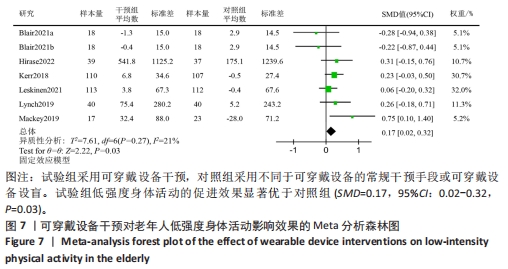
2.4.4 两组总身体活动差异的Meta分析结果 由图8可知,8项研究报告了可穿戴设备对老年人总身体活动的影响[8,29,33,36,47,52,55,65],各研究间异质性较小(I2=48%,P=0.06),故采用固定效应模型进行分析。结果显示,两组间总身体活动水平相比差异有显著性意义(SMD=0.15,95%CI:0.02-0.28,P=0.02),提示可穿戴设备干预可促进老年人总身体活动水平。
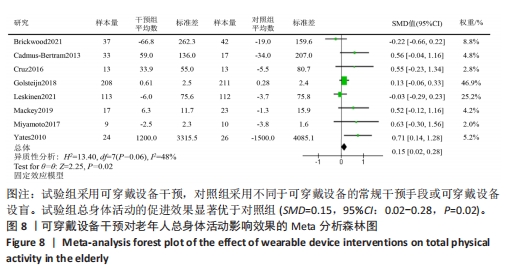
2.4.5 两组久坐行为差异的Meta分析结果 在图9中,8项研究报告了可穿戴设备对老年人久坐行为的影响[9,11,28,33,49,51-52,58],各研究间异质性较小(I2=27%,P=0.21),故采用固定效应模型进行分析。结果显示,试验组在减少久坐行为方面与对照组相比差异无显著性意义(SMD=-0.08,95%CI:-0.21-0.05,P=0.22)。
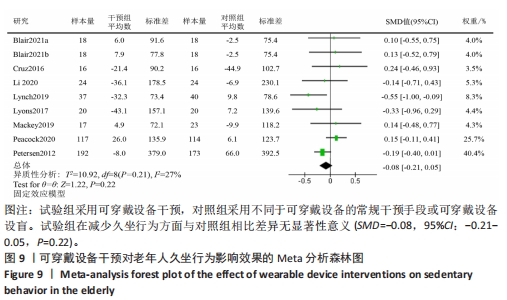
2.5 亚组分析结果 为进一步探究可穿戴设备对老年人身体活动表现的最佳设计策略,根据已有相关研究,选择干预措施、干预时间以及可穿戴设备的传感器类型[24,66],对老年人中高强度身体活动、低强度身体活动、总身体活动和每日步数4个身体活动指标进行亚组分析,而久坐行为由于所有亚组结果均无显著意义,因此没有进行深入分析。
2.5.1 两组中高强度身体活动差异的亚组Meta分析结果 将干预措施分为综合干预和单一干预2个亚组。综合干预定义为可穿戴设备作为联合人工(如团体信息会议、咨询、电话支持等)的组成部分;单一干预定义为独立于人工进行基于可穿戴设备的干预[24]。亚组分析结果显示(表4)。与单一干预相比(SMD=0.11,95%CI:-0.13-0.35,P=0.37),综合干预(SMD=0.32,95%CI:0.22-0.42,P < 0.001)对老年人中高强度身体活动有更加显著的促进效果。将干预时间分为干预时间≤12周和> 12周2个亚组,结果显示,与对照组相比,干预时间≤12周(SMD=0.50,95%CI:0.29-0.70,P < 0.001)或> 12周(SMD=0.22,95%CI:0.08-0.37,P=0.003)均能显著增加老年人的中高强度身体活动水平。将传感器类型分为加速度计和计步器2个亚组。计步器定义为用于记录个体所走的步数的一种便携式电子设备;加速度计定义为通过使用算法测量加速度力,可以用于准确检测个体身体活动的周期和强度的电子追踪器[67]。结果显示,与对照组相比,使用加速度计干预(SMD=0.33,95%CI:0.06-0.61,P < 0.001)或计步器干预(SMD=0.30,95%CI:0.19-0.41,P < 0.001)均能显著增加老年人中高强度身体活动水平。
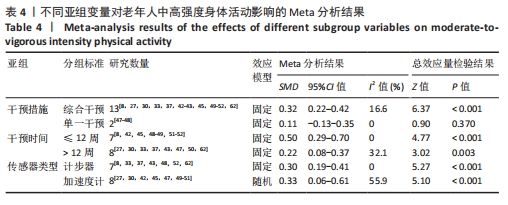
2.5.2 两组每日步数差异的亚组Meta分析结果 亚组分析结果显示(表5),对于干预措施,综合干预(SMD=0.49,95%CI:0.33-0.66,P < 0.001)或单一干预(SMD=0.40,95%CI:0.09-0.70,P=0.01)均能显著促进老年人的每日步数;对于干预时间,干预时间≤12周(SMD=0.46,95%CI:0.20-0.73,P < 0.001)或> 12周(SMD=0.45,95%CI:0.31-0.59,P < 0.001)均能显著促进老年人的每日步数;对于传感器类型,使用加速度计干预(SMD=0.56,95%CI:0.40-0.72,P < 0.001)或计步器干预(SMD=0.45,95%CI: 0.26-0.63,P < 0.001)均能显著增加老年人的每日步数。
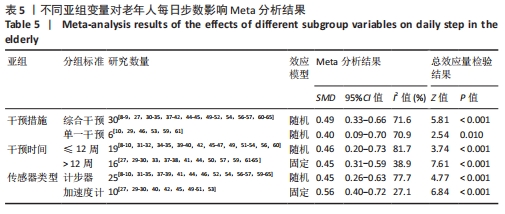
2.5.3 两组低强度身体活动差异的亚组Meta分析结果 亚组分析结果显示(表6),对于干预措施,与单一干预相比(SMD=0.02,95%CI:-0.22-0.27,P=0.850),综合干预(SMD=0.25,95%CI:0.07-0.44, P=0.008)对老年人低强度身体活动有更显著促进效果;对于干预时间,与干预时间> 12周相比(SMD=0.12,95%CI:-0.04-0.28,P=0.15),干预时间≤12周(SMD=0.42,95%CI:0.05-0.78,P=0.02)对老年人低强度身体活动有更显著促进效果;对于传感器类型,与加速度计相比(SMD=0.05,95%CI:-0.16-0.25,P=0.66),计步器(SMD=0.31,95%CI:0.09-0.52,P=0.005)干预对老年人低强度身体活动有更显著促进效果。
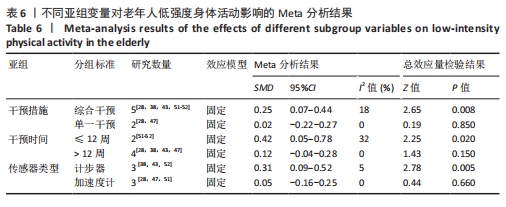
2.5.4 两组总身体活动差异的亚组Meta分析结果 亚组分析结果显示(表7),对于干预措施,与单一干预相比(SMD=0.06,95%CI:-0.09-0.20,P=0.43),综合干预(SMD=0.60,95%CI:0.28-0.91,P < 0.001)对老年人总身体活动有更加显著的促进效果;对于干预时间,与干预时间> 12周相比(SMD=0.13,95%CI:-0.11-0.38,P=0.29),干预时间≤12周(SMD=0.56,95%CI:0.16-0.95,P=0.005)对老年人总身体活动有更加显著的促进效果;对于传感器类型,与加速度计相比(SMD=-0.04,95%CI:-0.26-0.18,P=0.72),计步器(SMD=0.26,95%CI:0.09-0.42,P=0.002)干预对老年人总身体活动有更显著促进效果。
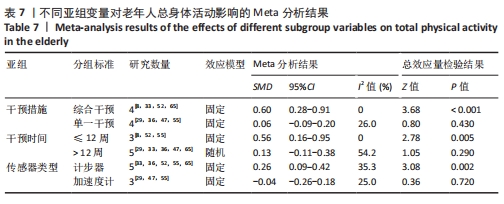
2.5.5 影响老年人每日步数效应量的异质性因素Meta回归结果 采用单因素Meta回归来探究异质性的显著影响因素。鉴于单变量Meta回归分析旨在筛选可能引起异质性的变量,为了确保不遗漏任何关键的影响因素,将检验标准P值放宽至 0.1[68]。结果显示(表8),发表年份、发表地区、性别、样本量以及文献质量这5个因素的P > 0.1,说明这些因素与每日步数研究间异质性无关;而年龄(P=0.038)和健康状况因素(P=0.083)的P < 0.1,说明年龄和健康状况是影响每日步数效应量的明显异质性来源。
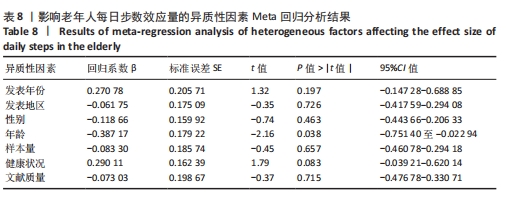
2.6 发表偏倚评价和敏感性分析结果 采用定量和定性的方法对纳入文献的发表偏倚进行评估。依据先前的研究经验,绘制漏斗图至少需10项研究数据,并且仅通过直观检查漏斗图可能得出错误的结论[69]。因此,文章联合使用Egger检验对纳入研究的发表偏倚进行定量分析,具体而言,针对报告每日步数和中高强度身体活动的研究,同时进行了Egger检验和漏斗图分析;针对低强度身体活动、总身体活动和久坐行为的研究,则仅执行了Egger检验。分析结果显示,每日步数和中高强度身体活动的漏斗图对称性欠佳,提示可能存在发表偏倚,见图10,11。然而Egger检验结果显示,所有指标P > 0.05,见表9,表明纳入的所有研究不存在发表偏倚。
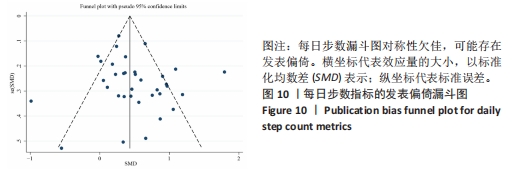
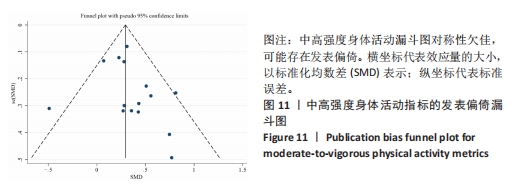
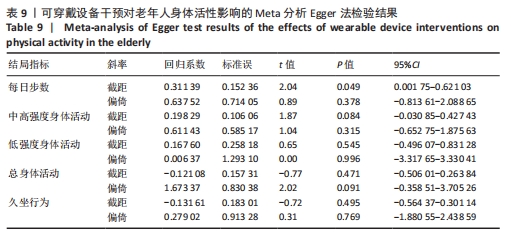
为了验证Meta分析结果的稳健性和评估单个研究对整体估计值的影响,文章采用Leave-One-Out方法进行敏感性分析,结果显示(图12-16),剔除任何一篇文献对每日步数、中高强度身体活动、低强度身体活动、总身体活动和久坐行为效应量影响不大,说明Meta分析结果较为稳定。
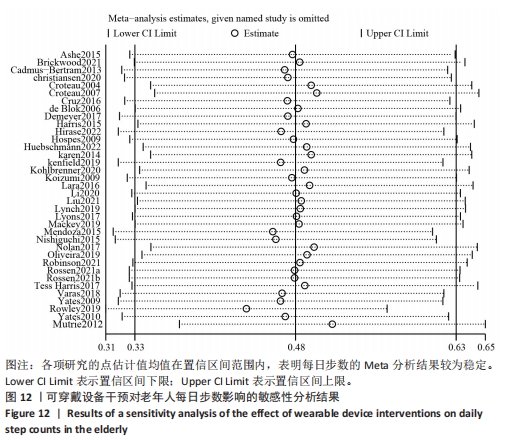
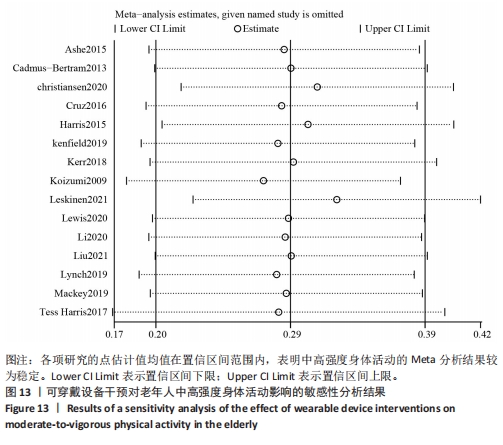
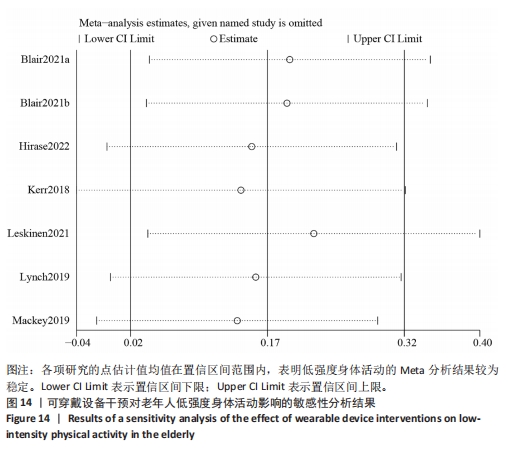
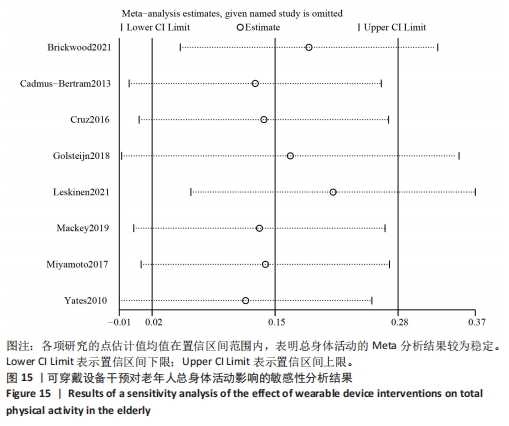

| [1] AMUTHAVALLI THIYAGARAJAN J, MIKTON C, HARWOOD RH, et al. The UN Decade of healthy ageing: strengthening measurement for monitoring health and wellbeing of older people. Age Ageing. 2022;51(7):afac147. [2] CHEN X, GILES J, YAO Y, et al. The path to healthy ageing in China: a Peking University-Lancet Commission. Lancet. 2022;400(10367):1967-2006. [3] STENSEL DJ. How can physical activity facilitate a sustainable future? Reducing obesity and chronic disease. Proc Nutr Soc. 2023;82(3):286-297. [4] D’ONOPRIO G, KIRSCHNER J, PRATHER H, et al. Musculoskeletal exercise: Its role in promoting health and longevity. Prog Cardiovasc Dis. 2023;77(4):25-36. [5] GOMES M, FIGUEIREDO D, TEIXEIRA L, et al. Physical inactivity among older adults across Europe based on the SHARE database. Age Ageing. 2017;46(1):71-79. [6] ZHOU Y, WU J, ZHANG S, et al. Prevalence and risk factors of physical inactivity among middle-aged and older Chinese in Shenzhen: a cross-sectional study. BMJ Open. 2018;8(10):e019775. [7] LEWIS ZH, LYONS EJ, JARVIS JM, et al. Using an electronic activity monitor system as an intervention modality: A systematic review. BMC Public Health. 2015;15(6):585-600. [8] CADMUS-BERTRAM L, WANG JB, PATTERSON RE, et al. Web-based self-monitoring for weight loss among overweight/obese women at increased risk for breast cancer: the HELP pilot study. Psycho-Oncol. 2013; 22(8):1821-1829. [9] LYONS EJ, SWARTZ MC, LEWIS ZH, et al. Feasibility and Acceptability of a Wearable Technology Physical Activity Intervention With Telephone Counseling for Mid-Aged and Older Adults: A Randomized Controlled Pilot Trial. JMIR Mhealth Uhealth. 2017; 5(3):e28. [10] NOLAN CM, MADDOCKS M, CANAVAN JL, et al. Pedometer Step Count Targets during Pulmonary Rehabilitation in Chronic Obstructive Pulmonary Disease. A Randomized Controlled Trial. Am J Respir Crit Care Med. 2017;195(10):1344-1352. [11] PEACOCK OJ, WESTERN MJ, BATTERHAM AM, et al. Effect of novel technology-enabled multidimensional physical activity feedback in primary care patients at risk of chronic disease-The MIPACT study: A randomised controlled trial. Int J Behav Nutr Phys Act. 2020;17(1):156-172. [12] BLOUNT DS, MCDONOUGH DJ, GAO Z. Effect of Wearable Technology-Based Physical Activity Interventions on Breast Cancer Survivors’ Physiological, Cognitive, and Emotional Outcomes: A Systematic Review. J Clin Med. 2021;10(9):2015-2034. [13] GAL R, MAY AM, VAN OVERMEEREN EJ, et al. The Effect of Physical Activity Interventions Comprising Wearables and Smartphone Applications on Physical Activity: a Systematic Review and Meta-analysis. Sports Med Open. 2018;4(1):42-48. [14] CHEATHAM SW, STULL KR, FANTIGRASSI M, et al. The efficacy of wearable activity tracking technology as part of a weight loss program: a systematic review. J Sports Med Phys Fitness. 2018;58(4):534-548. [15] OLIVEIRA J, SHERRINGTON C, ZHENG E, et al. Effect of interventions using physical activity trackers on physical activity in people aged 60 years and over: a systematic review and meta-analysis. Br J Sports Med. 2020;54(20):1188-1194. [16] COOPER C, GROSS A, BRINKMAN C, et al. The impact of wearable motion sensing technology on physical activity in older adults. Exp Gerontol. 2018;112(1):9-19. [17] PALUCH AE, BAJPAI S, BASSETT DR, et al. Daily steps and all-cause mortality: a meta-analysis of 15 international cohorts. Lancet Public health. 2022;7(3):e219-e228. [18] FISHMAN EI, STEEVES JA, ZIPUNNUKOV V, et al. Association between Objectively Measured Physical Activity and Mortality in NHANES. Med Sci Sports Exerc. 2016; 48(7):1303-1311. [19] BALLIN M, NORDSTROM P, NIKLASSON J, et al. Associations of Objectively Measured Physical Activity and Sedentary Time with the Risk of Stroke, Myocardial Infarction or All-Cause Mortality in 70-Year-Old Men and Women: A Prospective Cohort Study. Sports Med. 2021;51(2):339-349. [20] HIGGINS JP, ALTMAN DG, GØTZSCHE PC, et al. The Cochrane Collaboration’s tool for assessing risk of bias in randomised trials. BMJ. 2011;343:d5928. [21] GUYATT GH, OXMAN AD, SCHüNEMANN HJ, et al. GRADE guidelines: a new series of articles in the Journal of Clinical Epidemiology. J Clin Epidemiol. 2011;64(4): 380-382. [22] 吴洋,王宇,李柏辰,等.疏肝解郁法治疗冠心病合并抑郁的Meta分析及GRADE评价[J].中西医结合心脑血管病杂志,2024,22(9):1547-1554. [23] WAN X, WANG W, LIU J, et al. Estimating the sample mean and standard deviation from the sample size, median, range and/or interquartile range. BMC Med Res Methodol. 2014;14:135-148. [24] BRICKWOOD KJ, WATSON G, O’BRIEN J, et al. Consumer-Based Wearable Activity Trackers Increase Physical Activity Participation: Systematic Review and Meta-Analysis. JMIR Mhealth Uhealth. 2019;7(4):e11819. [25] HIGGINS JP, THOMPSON SG, DEEKS JJ, et al. Measuring inconsistency in Meta-analyse. BMJ. 2003;327:557-560. [26] MCHUGH ML. Interrater reliability: the kappa statistic. Biochem Med (Zagreb). 2012;22(3):276-282. [27] ASHE MC, WINTERS M, HOPPMANN CA, et al. “Not just another walking program”: Everyday Activity Supports You (EASY) model-a randomized pilot study for a parallel randomized controlled trial. Pilot Feasibility Stud. 2015;1(1):367-379. [28] BLAIR CK, HARDING E, WIGGINS C, et al. A home-based mobile health intervention to replace sedentary time with light physical activity in older cancer survivors: Randomized controlled pilot trial. JMIR Cancer. 2021;7(2):281-295. [29] BRICKWOOD KJ, AHUJA KDK, WATSON G, et al. Effects of activity tracker use with health professional support or telephone counseling on maintenance of physical activity and health outcomes in older adults: Randomized controlled trial. JMIR Mhealth Uhealth. 2021;9(1):369-382. [30] CHRISTIANSEN MB, THOMA LM, MASTER H, et al. Feasibility and Preliminary Outcomes of a Physical Therapist-Administered Physical Activity Intervention After Total Knee Replacement. Arthritis Care Res. 2020; 72(5):661-668. [31] CROTEAU KA, RICHESON NE, VINES SW, et al. Effects of a Pedometer-Based Physical Activity Program on Older Adults’ Mobility-Related Self-Efficacy and Physical Performance. Act Adapt Aging. 2004;28(2):19-33. [32] CROTEAU KA, RICHESON NE, FARMER BC, et al. Effect of a pedometer-based intervention on daily step counts of community-dwelling older adults. Res Q Exerc Sport. 2007;78:401-406. [33] CRUZ J, BROOKS D, MARQUES A. Walk2Bactive: A randomized controlled trial of a physical activity-focused behavioural intervention beyond pulmonary rehabilitation in chronic obstructive pulmonary disease. Chron Respir Dis. 2016; 13(1):57-66. [34] DE BLOK BM, DE GREEF MHG, TEN HACKEN NHT, et al. The effects of a lifestyle physical activity counseling program with feedback of a pedometer during pulmonary rehabilitation in patients with COPD: a pilot study. Patient Educ Couns. 2006;61(1):48-55. [35] DEMEYER H, LOUVARIS Z, FREI A, et al. Physical activity is increased by a 12-week semiautomated telecoaching programme in patients with COPD: a multicentre randomised controlled trial. Thorax. 2017; 72(5):415-423. [36] GOLSTEIJN RHJ, BOLMAN C, VOLDERS E, et al. Short-term efficacy of a computer-tailored physical activity intervention for prostate and colorectal cancer patients and survivors: a randomized controlled trial. Int J Behav Nutr Phys Act. 2018;15(1):106. [37] HARRIS T, KERRY SM, VICTOR CR, et al. A primary care nurse-delivered walking intervention in older adults: PACE (pedometer accelerometer consultation evaluation)-Lift cluster randomised controlled trial. PLoS Med. 2015;12(2):e1001783. [38] HIRASE T, INOKUCHI S, KOSHIKAWA S, et al. Preventive effect of an intervention program with increased physical activity on the development of musculoskeletal pain in community-dwelling older adults: A randomized controlled trial. Pain Med (Malden, Mass). 2022;28(3):581-593. [39] HOSPES G, BOSSENBROEK L, TEN HACKEN NHT, et al. Enhancement of daily physical activity increases physical fitness of outclinic COPD patients: results of an exercise counseling program. Patient Educ Couns. 2009;75(2):274-281. [40] HUEBSCHMANN AG, GLASGOW RE, LEAVITT IM, et al. Integrating a physical activity coaching intervention into diabetes care: a mixed-methods evaluation of a pilot pragmatic trial. Transl Behav Med. 2022; 12(4):601-610. [41] KAREN AC, NANCY ER, SUSAN WV, et al. Effects of a pedometer-based physical activity program on older adults’ mobility-related self-efficacy and physical performance. Act Adapt Aging. 2004;28:2. [42] KENFIELD SA, VAN BLARIGAN EL, AMELI N, et al. Feasibility, Acceptability, and Behavioral Outcomes from a Technology-enhanced Behavioral Change Intervention (Prostate 8): A Pilot Randomized Controlled Trial in Men with Prostate Cancer. Eur Urol. 2019;75(6):950-958. [43] KERR J, ROSENBERG D, MILLSTEIN RA, et al. Cluster randomized controlled trial of a multilevel physical activity intervention for older adults. Int J Behav Nutr Phys Act. 2018;15(1):32-47. [44] KOHLBRENNER D, SIEVI NA, SENN O, et al. Long-term effects of pedometer-based physical activity coaching in severe copd: A randomized controlled trial. Int J COPD. 2020;15:2837-2846. [45] KOIZUMI D, ROGERS NL, ROGERS ME, et al. Efficacy of an accelerometer-guided physical activity intervention in community-dwelling older women. J Phys Act Health. 2009;6(4):467-474. [46] LARA J, O’BRIEN N, GODFREY A, et al. Pilot randomised controlled trial of a web-based intervention to promote healthy eating, physical activity and meaningful social connections compared with usual care control in people of retirement age recruited from workplaces. PLoS One. 2016;11(7):292-308. [47] LESKINEN T, SUORSA K, TUOMINEN M, et al. The Effect of Consumer-based Activity Tracker Intervention on Physical Activity among Recent Retirees-An RCT Study. Med Sci Sports Exerc. 2021;53(8):1756-1765. [48] LEWIS ZH, OTTENBACHER KJ, FISHER SR, et al. Effect of electronic activity monitors and pedometers on health: Results from the TAME health pilot randomized pragmatic trial. Int J Environ Res Public Health. 2020;17:18. [49] LI LC, FEEHAN LM, XIE H, et al. Effects of a 12-Week Multifaceted Wearable-Based Program for People With Knee Osteoarthritis: Randomized Controlled Trial. JMIR Mhealth Uhealth. 2020;8(7):e19116. [50] LIU JYW, KWAN RYC, YIN YH, et al. Enhancing the physical activity levels of frail older adults with a wearable activity tracker-based exercise intervention: A pilot cluster randomized controlled trial. Int J Environ Res Public Health. 2021;18(19):781-795. [51] LYNCH BM, NGUYEN NH, MOORE MM, et al. A randomized controlled trial of a wearable technology-based intervention for increasing moderate to vigorous physical activity and reducing sedentary behavior in breast cancer survivors: The ACTIVATE Trial. Cancer. 2019;125(16):2846-2855. [52] MACKEY DC, PERKINS AD, TAI K H, et al. Men on the move: A randomized controlled feasibility trial of a scalable, choice-based, physical activity and active transportation intervention for older men. J Aging Phys Act. 2019;27(4):489-502. [53] MENDOZA L, HORTA P, ESPINOZA J, et al. Pedometers to enhance physical activity in COPD: A randomised controlled trial. Eur Respir J. 2015;45(2):347-354. [54] MUTRIE N, DOOLIN O, FITZSIMONS CF, et al. Increasing older adults’ walking through primary care: results of a pilot randomized controlled trial. Fam Pr. 2012;29(6):633-642. [55] MIYAMOTO T, FUKUDA K, OSHIMA Y, et al. Non-locomotive physical activity intervention using a tri-axial accelerometer reduces sedentary time in type 2 diabetes. Phys Sportsmed. 2017;45(3):245-251. [56] NISHIGUCHI S, YAMADA M, TANIGAWA T, et al. A 12-Week Physical and Cognitive Exercise Program Can Improve Cognitive Function and Neural Efficiency in Community-Dwelling Older Adults: A Randomized Controlled Trial. J Am Geriatr Soc. 2015;63(7):1355-1363. [57] OLIVEIRA JS, SHERRINGTON C, PAUL SS, et al. A combined physical activity and fall prevention intervention improved mobility-related goal attainment but not physical activity in older adults: a randomised trial. J Physiother. 2019;65(1):16-22. [58] PETERSEN CB, SEVERIN M, HANSEN AW, et al. A population-based randomized controlled trial of the effect of combining a pedometer with an intervention toolkit on physical activity among individuals with low levels of physical activity or fitness. Prev Med. 2012;54:125-130. [59] ROBINSON SA, COOPER JAJR, GOLDSTEIN RL, et al. A randomised trial of a web-based physical activity self-management intervention in COPD. ERJ Open Res. 2021; 7(3):461-472. [60] ROWLEY TW, LENZ EK, SWARTZ AM, et al. Efficacy of an individually tailored, Internet-mediated physical activity intervention in older adults: A randomized controlled trial. J Appl Gerontol. 2019;38:1011-1022. [61] ROSSEN J, HAGSTROMER M, YNGVE A, et al. Process evaluation of the Sophia Step Study- a primary care based three-armed randomized controlled trial using self-monitoring of steps with and without counseling in prediabetes and type 2 diabetes. BMC Public Health. 2021;21(1):1191-1203. [62] HARRIS T, KERRY SM, LIMB ES, et al. Effect of a primary care walking intervention with and without nurse support on physical activity levels in 45- to 75-year-olds: The pedometer and consultation evaluation (PACE-UP) cluster randomised clinical trial. Plos Med. 2017;14:e1002210. [63] VARAS AB, CORDOBA S, RODRIGUEZ-ANDONAEGUI I, et al. Effectiveness of a community-based exercise training programme to increase physical activity level in patients with chronic obstructive pulmonary disease: A randomized controlled trial. Physiother Res Int. 2018;23(4):e1740. [64] YATES T, DAVIES M, GORELY T, et al. Effectiveness of a pragmatic education program designed to promote walking activity in individuals with impaired glucose tolerance: a randomized controlled trial. Diabetes Care. 2009;32(8):1404-1410. [65] YATES T, DAVIES MJ, GORELY T, et al. The effect of increased ambulatory activity on markers of chronic low-grade inflammation: evidence from the PREPARE programme randomized controlled trial. Diabet Med. 2010;27(11):1256-1263. [66] LI C, CHEN X, BI X. Wearable activity trackers for promoting physical activity: A systematic meta-analytic review. Int J Med Inform. 2021;152(5):104487-104498. [67] WU S, LI G, DU L, et al. The effectiveness of wearable activity trackers for increasing physical activity and reducing sedentary time in older adults: A systematic review and meta-analysis. Digit Health. 2023;9: 1-13. [68] 王从江.体育锻炼对我国普通大学生抑郁症影响的Meta分析[J].成都体育学院学报,2014,40(3):75-79. [69] DEBRAY TPA, MOONS KGM, RILEY RD. Detecting small-study effects and funnel plot asymmetry in meta-analysis of survival data: A comparison of new and existing tests. Res Synth Methods. 2018; 9(1):41-50. [70] ROBERTS AL, FISHER A, SMITH L, et al. Digital health behaviour change interventions targeting physical activity and diet in cancer survivors: a systematic review and meta-analysis. J Cancer Surviv. 2017;11(6): 704-719. [71] SAINT-MAURICE PF, TROIANO RP, BASSETT DRJR, et al. Association of Daily Step Count and Step Intensity With Mortality Among US Adults. JAMA. 2020;323(12):1151-1160. [72] D’AMORE C, REID JC, CHAN M, et al. Interventions Including Smart Technology Compared With Face-to-face Physical Activity Interventions in Older Adults: Systematic Review and Meta-analysis. J Med Internet Res. 2022;24(10):e36134. [73] LIU JY, KOR PP, CHAN CP, et al. The effectiveness of a wearable activity tracker (WAT)-based intervention to improve physical activity levels in sedentary older adults: A systematic review and meta-analysis. Arch Gerontol Geriatr. 2020;91:104211-104230. [74] EKELUND U, TARP J, FAGERLAND MW, et al. Joint associations of accelero-meter measured physical activity and sedentary time with all-cause mortality: a harmonised meta-analysis in more than 44 000 middle-aged and older individuals. Br J Sports Med. 2020;54(24):1499-1506. [75] MEH K, SEMBER V, SORIC M, et al. The dilemma of physical activity questionnaires: Fitter people are less prone to over reporting. PLos One. 2023;18(8):e0285357. [76] MICHIE S, RICHARDSON M, JOHNSTON M, et al. The behavior change technique taxonomy (v1) of 93 hierarchically clustered techniques: building an international consensus for the reporting of behavior change interventions. Ann Behav Med. 2013;46(1):81-95. [77] GAO Z, RYU S, ZHOU W, et al. Effects of personalized exercise prescriptions and social media delivered through mobile health on cancer survivors’ physical activity and quality of life. J Sport Health Sci. 2023; 12(6):705-714. [78] ISLAM KF, AWAL A, MAZUMDER H, et al. Social cognitive theory-based health promotion in primary care practice: A scoping review. Heliyon. 2023;9(4):e14889. [79] ZUBALA A, MACGILLIVRAY S, FROST H, et al. Promotion of physical activity interventions for community dwelling older adults: A systematic review of reviews. PLoS One. 2017;12(7):e0180902 [80] AUERSWALD T, MEYER J, VON HOLDT K, et al. Application of Activity Trackers among Nursing Home Residents-A Pilot and Feasibility Study on Physical Activity Behavior, Usage Behavior, Acceptance, Usability and Motivational Impact. Int J Environ Res Public Health. 2020;17(18):6683-6704. [81] HODKINSON A, KONTOPANTELIS E, ADENIJI C, et al. Interventions Using Wearable Physical Activity Trackers Among Adults With Cardiometabolic Conditions: A Systematic Review and Meta-analysis. JAMA Netw Open. 2021;4(7):e2116382. [82] LARSEN RT, CHRISTENSEN J, JUHL CB, et al. Physical activity monitors to enhance amount of physical activity in older adults - a systematic review and meta-analysis. Eur Rev Aging Phys Act. 2019;16(1):7. [83] STOCLWELL S, SCHOFIELD P, FISHER A, et al. Digital behavior change interventions to promote physical activity and/or reduce sedentary behavior in older adults: A systematic review and meta-analysis. Exp Gerontol. 2019;120:68-87. |
| [1] | 张新新, 高 克, 谢世栋, 陀浩雯, 经飞跃, 刘卫国. 非手术治疗慢性踝关节不稳者足踝功能和动态平衡能力的网状Meta分析[J]. 中国组织工程研究, 2025, 29(9): 1931-1944. |
| [2] | 孙韫頔, 程露露, 万海丽, 常 赢, 熊雯娟, 夏 渊. 神经肌肉训练对膝骨关节炎患者疼痛和功能影响的Meta分析[J]. 中国组织工程研究, 2025, 29(9): 1945-1952. |
| [3] | 张雨馨, 于 聪, 张 翠, 丁建军, 陈 岩. 轻度认知障碍老人与认知正常老人在不同单双任务下姿势控制能力的差异性[J]. 中国组织工程研究, 2025, 29(8): 1643-1649. |
| [4] | 王艺达, 刘 君, 王晓玲, 王丽岩, 杨程茹, 张学晓. 基于可穿戴电子设备干预对健康青少年身体活动和久坐行为影响的Meta分析[J]. 中国组织工程研究, 2025, 29(8): 1693-1704. |
| [5] | 张孜贤, 徐有粮, 吴绍奎, 王相英. 血流限制训练法联合抗阻训练对运动者肌肉相关指标影响的Meta分析[J]. 中国组织工程研究, 2025, 29(8): 1705-1713. |
| [6] | 王 娟, 王广兰, 左会武. 运动疗法对前交叉韧带重建后康复疗效影响的网状Meta分析[J]. 中国组织工程研究, 2025, 29(8): 1714-1726. |
| [7] | 郑华坤, 殷明越, 刘 骞. 间歇与持续训练对体力活动不足成人生活质量影响的Meta分析[J]. 中国组织工程研究, 2025, 29(8): 1727-1740. |
| [8] | 李慧军, 李黄岩, 张业廷. 身体活动与老年人认知领域研究热点与主题演变[J]. 中国组织工程研究, 2025, 29(5): 1073-1080. |
| [9] | 李 哲, 李 萍, 张 超, 郭广玲. 不同来源间充质干细胞治疗卵巢早衰动物模型疗效的网状Meta分析[J]. 中国组织工程研究, 2025, 29(36): 7898-7908. |
| [10] | 王凯刚, 郝东升, 马 沛, 周 硕, 李睿敏. 对比不同生物支架用于年轻恒牙牙髓血运重建效果的贝叶斯网状Meta分析[J]. 中国组织工程研究, 2025, 29(34): 7447-7460. |
| [11] | 王 贺, 于少泓, . 经颅直流电刺激改善脑卒中患者下肢运动功能障碍的Meta分析[J]. 中国组织工程研究, 2025, 29(30): 6556-6565. |
| [12] | 王建磊 , 何培亮 , 孙永建. 下肢关节置换前糖皮质激素静脉注射对疗效及安全性影响的Meta分析[J]. 中国组织工程研究, 2025, 29(3): 599-607. |
| [13] | 李 佳, 刘倩茹, 邢梦楠, 陈 波, 矫 玮, 孟兆祥. 不同运动类型对膝骨关节炎患者疗效的网状Meta分析[J]. 中国组织工程研究, 2025, 29(3): 609-616. |
| [14] | 周琰杰, 曹春风, 张中卒, 牛 雄, 王 鑫, 杨再海, 周 亮, 李 波. 颈前路减压融合ROI-CTM自锁系统治疗退行性颈椎病的Meta分析[J]. 中国组织工程研究, 2025, 29(3): 617-627. |
| [15] | 蒋思琪, 黄欢欢, 余馨雨, 彭 颖, 周 薇, 赵庆华. 运动改善社区居家老年肌少症患者肌肉健康剂量效应的Meta分析[J]. 中国组织工程研究, 2025, 29(29): 6295-6304. |
可穿戴设备是指利用穿戴式技术测量并提供用户日常身体活动反馈的一种便携式设备[7]。研究表明,可穿戴设备干预可以提高身体活动水平,例如CADMUS-BERRAM等[8]研究发现,计步器联合运动指导可以显著增加老年人的每日步数;LYONS等[9]研究表明,加速度计干预对老年人每日步数和久坐行为有积极影响。但也有学者发现,可穿戴设备干预在增加老年人每日步数及改善久坐行为方面并无显著效果[10-11]。因此,可穿戴设备促进老年人身体活动的有效性仍存争议。虽然,关于可穿戴设备促进身体活动的Meta分析研究成果已有发表,但这些研究在方法学上存在一些局限,例如混合了不同的研究设计和干预类型[12-13]、访问的数据库数量较少[14]、纳入试验数量不足以及仅进行叙述性综述[12,14];此外,这些研究多集中于60岁以下或特定健康状况的人群,一定程度上限制了对老年群体的普适性。
迄今为止,仅有2篇综述探讨了可穿戴设备对60岁以上老年人身体活动的影响,但主要关注每日步数指标[15-16]。步数作为评估活动水平的关键指标,与降低老年人死亡风险密切相关[17],然而仅凭步数无法全面评估老年人的身体活动状况,特别是当需要综合考量身体活动的时间和强度时。因此,探索如总身体活动水平、活动强度和久坐行为等其他健康相关指标变得尤为重要,这些指标与死亡率和健康结果同样紧密相关[18-19]。为了填补现有证据的缺口,该文采用Meta分析方法全面评估了可穿戴设备对老年人中高强度身体活动、低强度身体活动、总身体活动、每日步数和久坐行为的影响,旨在为今后利用可穿戴设备干预老年人身体活动提供循证医学证据和客观参考依据。 中国组织工程研究杂志出版内容重点:生物材料;骨生物材料;口腔生物材料;纳米材料;缓释材料;材料相容性;组织工程
1.1.1 检索者 由第一作者和通讯作者严格按照《PRISMA 2020 声明》独立进行文献检索。
1.1.2 检索数据库 应用计算机检索PubMed、EMbase、Scopus、Ovid-Medline、SPORTDiscus、The Cochrane Library、CNKI、维普和万方数据库中的相关文献。
1.1.3 检索词 中文检索词为“可穿戴设备,可穿戴装置,计步器,加速度计,活动监视器,身体活动,体育运动,运动,锻炼,老年人,老人,随机对照试验”等。英文检索词为“Accelerometry,Actigraphy,Wearable Electronic Devices,Fitness Trackers,pedomet*,step count,fitness tracker*,accelerometer,Fitbit,Exercise,physical activit*,Physical Exercise*,Aged,elderly,elderly subject,Randomized Controlled Trial,RCT等”。
1.1.4 检索时间范围 检索时限均为各数据库建库至2024-03-10。
1.1.5 文献检索策略 由2名研究人员采用主题词结合自由词的方式进行系统检索,以PubMed数据库为例,见图1。

1.2.1 纳入标准 ①研究对象:≥60岁老年人(性别和健康状况不限);②干预措施:试验组采用可穿戴设备干预,并且干预持续时间≥2周;③对照措施:采用不同于可穿戴设备的常规干预手段或可穿戴设备设盲;④结局指标:中高强度身体活动、低强度身体活动、总身体活动、每日步数、久坐行为;⑤研究设计:随机对照试验。其中,涉及含多组研究和多个干预时长的随机对照试验时,提取离随访时间最近且符合此次研究的数据。
1.2.2 排除标准 ①质性研究、会议论文、硕士及博士论文、非核心论文合集、文献综述、个案研究、病例报告;②无法获取全文的文献;③重复发表的文献;④文献数据缺失或无法提取,联系原作者后依旧无法获得原始数据。⑤文献质量评分< 3分。
1.3 文献筛选和资料提取 由第一作者和通讯作者独立根据拟定的纳入和排除标准进行文献初筛后,根据既定的《数据信息提取表》独立提取资料并交叉核对。如有分歧,共同讨论解决或咨询相关专家。资料提取的基本信息包括第一作者、发表年份、国家信息、研究对象的类型和年龄、干预措施、干预时间及干预前后结局指标的平均值和标准差。
1.4 文献质量评估 由第一作者和通讯作者独立采用Cochrane偏倚风险评估工具对文献质量进行评价[20],主要从随机序列生成、分配隐藏、参与者盲法、评定者盲法、数据不完整、选择性报告和其他偏倚7个方面进行,根据 3个偏倚风险等级(低风险、高风险和不清楚)进行质量评分,将纳入文献的质量分为2个等级:5-6分为高质量文献,3-4分为中等质量文献。若存在不同意见,共同讨论解决或咨询相关专家。
运用GRADE系统对纳入研究的证据质量进行分级,主要从偏倚风险、不一致性、不精确性、间接性和发表偏倚5个维度进行评估,并根据不同的证据等级分为高质量(不降级)、中等质量(降1级)、低质量(降2级)和极低质量(降3级)[21]。表1展示了文章基于以往研究制定的GRADE评估标准及证据质量降级的依据[22]。
1.5 结局指标 ①每日步数;②中高强度身体活动;③低强度身体活动;④总身体活动;⑤久坐行为。
1.6 统计学分析 采用Review Manager 5.2和Stata 12.0软件对纳入的数据进行统计学处理。为综合评价干预效果,计算了每个研究组基线至干预后结局指标的平均值和标准差的变化。对于原始研究未直接提供平均值和标准差的情况,通过联系作者获取,或根据Cochrane推荐的方法进行推算。若原始研究仅报告了中位数、范围、四分位数间距和标准误差时,则采用WAN等[23]提出的计算公式近似估算平均值和标准差。鉴于文章纳入的数据均为连续性变量,并且存在度量衡单位不完全一致的情况,故选择标准化均数差(Standardized Mean Difference,SMD)为效应分析统计量和95%可信区间(Confidence Interval,CI)为效应
尺度。同时,考虑到大多数纳入研究的样本量较小,使用Hedges’g来计算SMD,并对小样本偏差进行了校正。效应量的大小根据SMD值分为4个等级:SMD < 0.2时为微小效应量,0.2≤SMD < 0.5为小效应量,0.5≤SMD < 0.8为中等效应量,SMD≥0.8为大效应量。
为了能够更好地转移到当前体育活动指南,研究依照BRICKWOOD等[24]的做法对部分数据做了以下调整:①将以每天中高强度身体活动分钟数表示的数据乘以7,以计算每周中高强度身体活动的分钟数;②将每天久坐行为以小时数表示的数据乘以60得出每天久坐分钟数。当检验水准为P < 0.05时,提示干预组和对照组之间存在显著性差异,证明Meta分析有统计学意义。采用I2定量分析研究间的异质性大小,当P > 0.1且I2 < 50%时认为各研究间同质性较好,采用固定效应模型;否则采用随机效应模型[25],并进行亚组分析和单因素Meta回归寻找异质性来源。通过漏斗图法和Egger检验对各项研究中可能存在的发表偏倚进行评估,若漏斗图大致对称或Egger检验的P > 0.05时,认为研究间不存在显著的发表偏倚;反之,则表明可能存在发表偏倚。采用留一法(Leave-One-Out)进行敏感性分析,以验证合并效应量的稳定性和评估单个研究对整体估计值的影响。
采用Cohen’s kappa方法检验2位评价者在文献纳入与排除、质量评价和数据提取中的一致性。根据Cohen’s kappa系数,一致性被划分为3个等级:当系数≤0.60时表示一致性较差,系数在0.61-0.80之间时为中等程度的一致性,系数≥0.81时则认为一致性较好[26]。该研究统计学方法已经过华南理工大学生物统计学专家核实。
3.2 可穿戴设备干预对老年人身体活动的影响 此次研究结果显示,可穿戴设备干预对老年人身体活动有显著的促进作用,具体而言,与对照组相比,可穿戴设备干预在促进老年人中高强度身体活动方面显示出积极的效果(SMD=0.29),相当于每周中高强度身体活动增加25 min,总体合并效应量较小,但证据质量评定为中等,这从临床角度来看很重要,因为它占据了世界卫生组织推荐老年人每周150 min中高强度身体活动的17%。
ROBERTS等[70]进行的一项Meta分析也显示出类似的增加,他们发现当老年癌症幸存者采取数字技术干预措施以促进中高强度身体活动时,每周中高强度身体活动参与时间增加约40 min。
此次研究结果显示,可穿戴设备干预与老年人每日步数的显著增加有关(SMD=0.48),相当于每天多走1 217步,整体合并效应量较小,证据质量评定为低,这一发现与现有的Meta分析结果相似[16]。在解释每天多走1 217步的效果方面,目前并没有明确的公共卫生指南表明对老年人的健康益处有多大,但既往研究已经发现,成年人每天多走1 000步,全因死亡风险的降低约15%[71],这可能对老年人也有类似的效益,但还需更多的研究进一步提供证据。此次研究还发现,可穿戴设备干预可以显著提高老年人低强度身体活动和总身体活动水平,这与D’AMORE等[72]和LIU等[73]的综述研究结果一致。和参与中高强度身体活动已知的广泛益处相比,老年人在日常生活中更倾向于从事低强度身体活动,尽管如此,先前研究已经证明,即使是低强度身体活动,也与老年人显著降低的死亡风险有关[74]。值得注意的是,大部分测量总身体活动的文献依赖于参与者的自我报告,这可能导致实际总身体活动水平被高估[75],因此,必须审慎解释这一结果。总之,这些研究结果表明,可穿戴设备在促进老年人体育活动参与方面起着重要作用,可穿戴设备的促进作用可以从以下几个方面来解释:根据行为改变技术模型[76],可穿戴设备可以通过目标设定、行动提示以及提供身体活动水平的反馈与奖励来促进身体活动;可穿戴设备可以通过用户自我监控促进自我效能感进而促进健康行为[77],研究已证明,自我效能感可以预测并维持成年人的身体活动行为[78]。
干预措施的亚组分析显示,无论是综合干预还是单一干预,可穿戴设备均能提高老年人的身体活动水平。特别是与单一干预相比,综合干预措施对老年人每日步数、中高强度身体活动、总身体活动产生了更大的效应量,表明基于可穿戴设备的干预本身是有效的,并且当其与其他行为改变技术(如电话支持或小组激励会议)相结合时身体活动的促进效果可能更佳。然而,综合干预措施中每个单独的组成部分的独立贡献无法通过Meta分析来确定。在文章纳入的43项研究中,只有3项研究直接比较了单一干预和综合干预的效果,其中2项研究提供了社会支持[28,61],这2项研究结果表明,相比于对照组或未接受社会支持的老年人,接受社会支持的老年人的每日步数、总身体活动、低强度身体活动均有显著提高。既往研究也表明,如果存在有意义的激励因素,例如社会和环境支持和个性化指导,而不是纯粹的可穿戴设备干预,老年人更有可能参与身体活动,提高干预的效果和依从性[79]。在干预时间方面,此次研究发现,与持续时间较长的干预相比(> 12周),持续时间较短的干预 (≤12周)对老年人中高强度身体活动、总身体活动和每日步数产生了更大影响,这与WU等[67]的综述研究结果一致,对此的解释可能与老年人对可穿戴设备的依从性以及在这些研究中采取各种辅助干预措施的作用有关。AUERSWALD等[80]的研究也发现,当干预时间超过5周时,受试者身体活动的促进能力逐渐降低,表明可穿戴设备的影响会随着时间推移而减弱。AUERSWALD等[80]推测,基于可穿戴设备促进身体活动的效果会受到干预持续时间“最佳点”的影响,当干预持续时间超过“最佳点”时,老年人对使用可穿戴设备的新颖性和兴趣消失,导致干预效果逐渐减弱甚至消失。在设备类型方面,此次研究发现,与使用加速度计相比,采用计步器的干预设备能够显著增加老年人低强度身体活动和总身体活动水平,这种积极影响可能源于计步器用户界面的直观性、便携性设计以及其清晰的大屏幕显示的特点,这些特性使得老年人更容易接受和持续使用该设备。因此,计步器不仅作为一种活动监测工具,也可能作为一种促进身体活动的激励工具。相反,目前的研究发现,使用加速度计在促进老年人每日步数和中高强度身体活动水平上优于计步器干预,这与先前的Meta分析结果相一致[66],表明详细监测身体活动信息而非简单记录步数可能对促进老年人中高强度身体活动和每日步数更有效。相比之下,HODKINSON等[81]的Meta分析结果显示,使用计步器干预比加速度计干预更能增加受试者的身体活动。然而需要指出的是,HODKINSON等的研究并未分别评估每日步数和中高强度身体活动,而是将计步器对每日步数的影响和加速度计对中高强度身体活动的影响进行比较。由于该文合并基于加速计和计步器的可穿戴设备的每日步数效应量大于中高强度身体活动,因此可以合理的假设,在HODKINSON等[81]的研究中计步器的干预效应被夸大了。加速度计和计步器作为可穿戴设备,在促进老年人身体活动方面出现效果不一致的内在原理也可能归因于加速度计能够提供更全面的活动信息,包括强度、持续时间和类型,而计步器主要记录步数,可能无法充分反映活动的多样性和强度。此外,加速度计可能因更精确的测量和反馈增强了用户的自我监控能力,从而更有效地促进身体活动,这提示未来的研究和开发工作应专注于设计和实施更符合老年人需求的可穿戴设备,以进一步提高其活动水平和生活质量。
3.3 可穿戴设备干预对老年人久坐行为的影响 久坐行为是身体活动的重要参考指标。此次研究结果显示,与对照组相比,可穿戴设备干预在减少老年人久坐时间上没有显著差异,这与LARSEN等[82]的研究结论一致。然而先前的研究结果显示[67,83],基于可穿戴设备的干预措施减少老年人久坐时间是切实可行的,但文章的研究结果并不支持这一结论,分析认为:在现有的基于可穿戴设备干预的研究中,这些设备主要用于激励个体有意识地增加身体活动,如努力达到每日步数目标或每周中高强度身体活动目标,而不是直接针对改变久坐等习惯性行为。LI等[66]的研究也支持这一观点,他们指出:虽然有意识的行为调节策略(例如监测、目标设定和反馈)通常应用于现有的可穿戴设备干预设计中,但专门用于逆转习惯性行为的研究设计在当前基于可穿戴设备促进身体活动的研究中并不常见,这可能解释了文章观测到可穿戴设备干预并没有改善老年人久坐行为的原因。因此,在解释可穿戴设备干预对久坐行为的影响时需要谨慎,未来仍需高质量、大样本的随机对照试验进一步验证现有证据。
3.4 研究的局限性 ①在解释每日步数和中高强度身体活动的益处时,文章采用SMD转换为步数和每周中高强度身体活动时间,虽然转换可以使研究结果更容易理解,但对于此解释结果的广泛推广可能产生限制;②尽管文章结果表明,可穿戴设备联合多方面干预组件可以显著促进老年人的身体活动,但由于多方面干预组件往往包含2个或以上的组成部分(如网站、日记和电话支持),因此目前的研究尚不清楚这些组成部分中任何一个的独立贡献;③由于纳入分析的老年人大多为欧州、北美洲和澳洲人群,因而该研究结果应谨慎用于亚洲老年人群;④文章未能充分探讨可穿戴设备佩戴位置对活动监测准确性的影响,由于可穿戴设备可以佩戴在腰间、臀部、腕部等不同身体部位,佩戴位置的不同可能会对监测到的身体活动数据产生显著差异;⑤文章结局指标虽涵盖每日步数、总身体活动、低强度身体活动、中高强度身体活动及久坐时间,但未单独区分中等强度和剧烈强度身体活动,这可能导致对可穿戴设备在促进不同强度活动方面的具体效果理解不足;⑥虽然文章在中高强度身体活动、总身体活动和久坐行为等结局指标中未发现显著的统计学异质性,但这些指标的研究在干预措施、时间以及老年人的健康状况方面存在差异,可能导致了潜在的方法学异质性和临床异质性。
3.5 研究适用性及对未来研究的启示 文章通过Meta分析证实了可穿戴设备在促进老年人身体活动方面的重要潜力,这对公共健康实践具有显著意义。考虑到身体活动在提升老年人健康和福祉中的关键作用,文章结果特别支持在老年人群中推广可穿戴设备,这不仅有助于增强其身体活动水平,还可能减少与久坐生活方式相关的健康风险。然而,由于文章中每日步数和久坐行为证据质量较低,并且缺乏对中等强度和剧烈强度身体活动的分析,以及在中高强度身体活动、总身体活动和久坐行为结局指标表现出的方法学和临床异质性,未来研究应开展更高标准的随机对照试验,这包括制定统一的干预措施、采用一致的评估工具和实施标准化的数据报告方法,以减少特定结局指标研究间的异质性。此外,还应进一步细化对不同活动强度的分析,以确保研究结论的深入性和广泛适用性。
在干预措施设计上,建议采用多策略组合,如结合教育、个性化目标和社会支持,以增强长期效果。此外,更多研究应通过更严格的试验设计来评估可穿戴设备与其他干预措施的独立效应,探索其与可穿戴设备的最优结合方式。个性化和定制化干预以及跨文化和地区的研究也应是未来研究的重要方向,以确保干预措施的广泛适用性和文化敏感性。
3.6 结论 ①可穿戴设备干预可以显著提升老年人的每日步数、中高强度身体活动、低强度身体活动和总身体活动水平;②采用综合干预措施与计步器结合使用,并且干预时间≤12周时,对促进老年人的低强度身体活动和总身体活动水平更佳;③采用综合干预措施与加速度计结合使用,并且干预时间≤12周时,对老年人的每日步数和中高强度身体活动的促进效益更大;④可穿戴设备干预对老年人久坐行为的改善效果尚不明确,提示未来需要开展更高质量和更大样本量的随机对照试验,以进一步验证可穿戴设备在减少久坐行为方面的效果。然而,文章的结论应当在考虑其局限性的前提下进行解读,尽管文章揭示了可穿戴设备对促进老年人身体活动的积极作用,但结论的普适性受限于研究设计、样本来源和干预措施的多样性。未来的研究应解决这些局限性,以确保结果的广泛适用性和深入理解干预的独立效应。 中国组织工程研究杂志出版内容重点:生物材料;骨生物材料;口腔生物材料;纳米材料;缓释材料;材料相容性;组织工程
 #br#
#br#
文题释义:
可穿戴设备:应用穿戴式技术对人们日常的穿戴进行智能化配置,可以用来客观测量用户日常身体活动,通过监视显示器或合作应用程序提供反馈的便携式设备。身体活动:以骨骼肌牵引为特征的各种活动。身体活动结果是身体能量的利用和运动功能的参与。
面对全球人口老龄化的挑战,促进老年人身体活动对于维持健康和减轻社会经济负担至关重要。然而,老年人常因多种障碍难以达到世界卫生组织推荐活动量。文章通过Meta分析首次全面评估了可穿戴设备干预的效果,为科学促进老年人身体活动提供了证据。研究结果显示,可穿戴设备干预显著提升了老年人的每日步数、中高强度身体活动、低强度身体活动和总身体活动水平。特别是,采用综合干预措施,结合计步器或加速度计,并控制在12周内的干预,对提高干预效果具有关键作用。尽管对减少久坐行为的效果尚需进一步研究,但研究结果为设计有效的老年人身体活动干预方案提供了循证支持,并为应对全球人口老龄化挑战提供了新的视角和策略。
| 阅读次数 | ||||||
|
全文 |
|
|||||
|
摘要 |
|
|||||